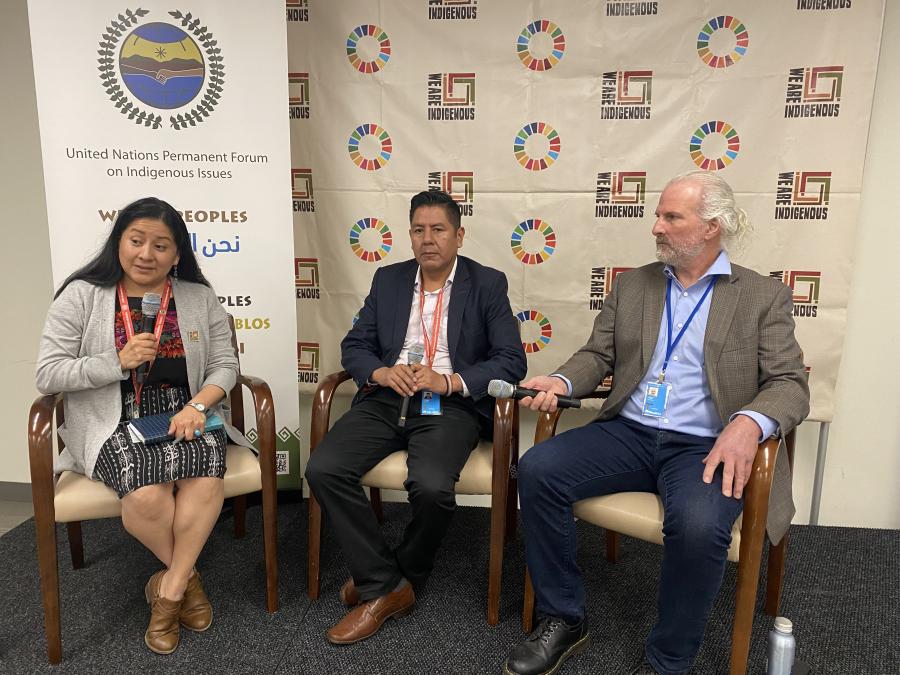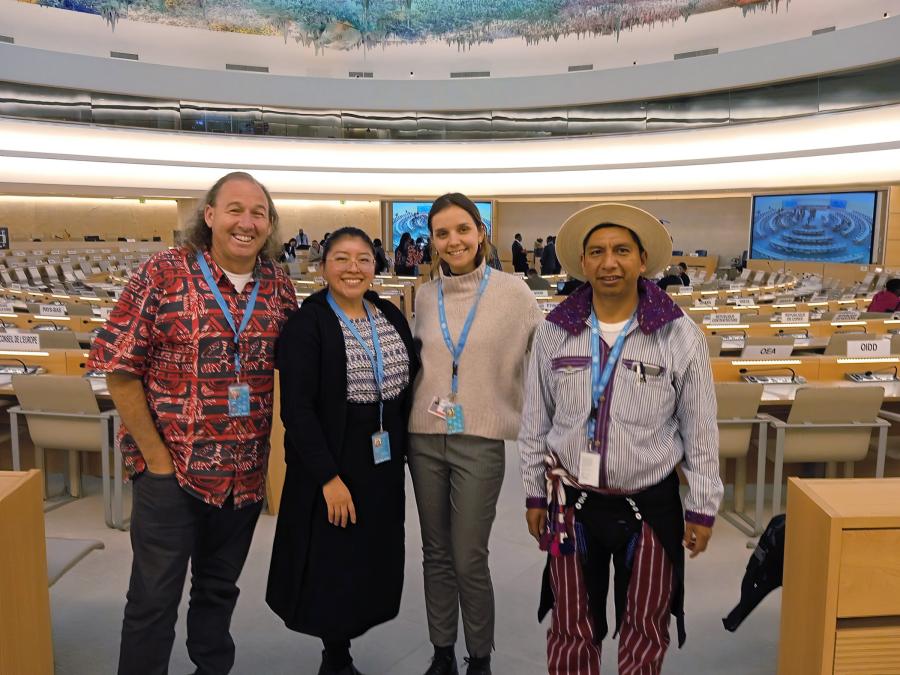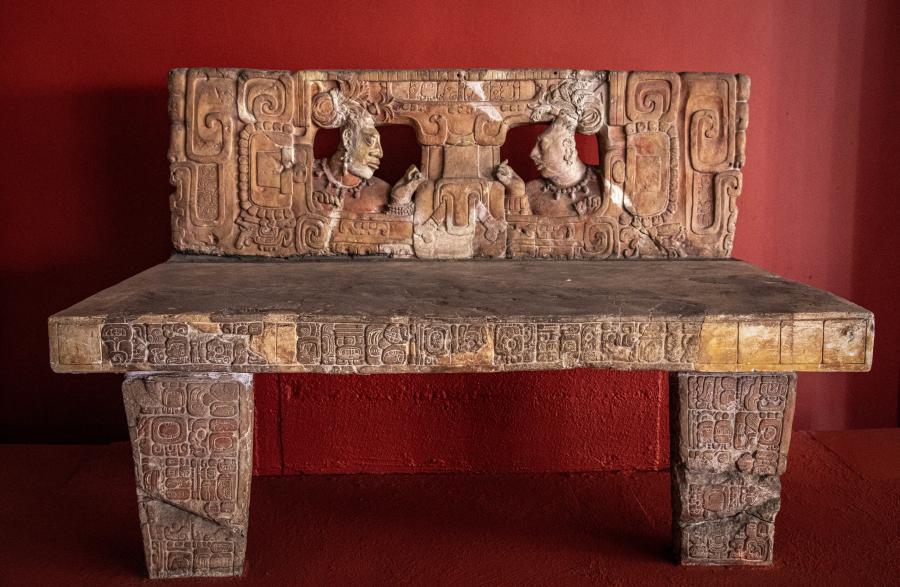Maya Achì: The Story of a Forced Resettlement
The Chixoy dam was built in the area where the Maya Achì have lived for hundreds of years -- the department of Alta and Baja Verapaz, a region that holds approximately 75,000 Achì speaking Maya people. The project began during the period of military dictatorship in Guatemala and the dam was built in the midst of a violent civil war fought between the army and armed opposition groups. The construction of the dam was heavily affected by the war, the "tierra arrasada" strategy, and the "forced resettlement" policy adopted by the military junta of Rios Montt in order to control guerrilla warfare in the country's inner areas by means of militarized "model villages."
In the late 1970s the largest community living along the banks of the Chixoy river, in what would later become the dam basin, was the Rio Negro, numbering 791 people. Out of the 463 families officially recognized as affected by INDE (Guatemala's National Institute of Electrification) in 1976, the majority were from Rio Negro (until the massacres of 1981 the strongest group in terms of culture and with an entirely indigenous population). The basin though, planned for 50 km along the river, would affect more than 4000 people living along the river's embankments.
Each family farmed its own parcel of land and many of them raised horses and livestock, devoted themselves to fishing using traditional systems, and farmed corn, beans, tomatoes, chilly, oranges, mania and ayote along the wide river banks, the only fertile lands. They also had common lands for pasture and firewood and other natural resources.
Just occasionally, some individuals from Rio Negro families joined the thousands of Guatemalan subsistence farmers as seasonal workers harvesting cotton, sugar or coffee on the large plantations on the country's Southern coast. There were no roads leading to Rio Negro. Rabinal, the nearest market, was an eight hour trip, walking, along a mountain path.
In 1975 INDE publicly announced the Chixoy project. Its objective was to develop a reliable source of cheap and abundant energy. In a period of deep crisis in Guatemala, dams were to be used to cut the high costs of oil purchase.
Funding for the project came first from the Inter-American Development Bank (IDB) in 1976, and then from The World Bank (WB) -- already involved for many years in restructuring the Guatemalan energy sector -- in 1978:$105 million and $72 million respectively. A further 14 billion lira were allocated by Italian bilateral aid in 1992 -- in favor of Cogefar-Impresit -- as aid credit for maintenance of the Chixoy hydroelectrical plant.
Local Community Opposition to the Dam
Initial consultations took place only in 1976, after the dam construction had already started. INDE representatives flew over Rio Negro by helicopter to inform people that a dam would be built and that the resulting reservoir would submerge their lands. After that time, consultations, envisaged by WB directives, between INDE and local indigenous peoples, took place in a climate of terror and intimidation. In 1980 INDE asked two representatives from the community to go to its offices to claim their rights over the lands; their mutilated bodies were later discovered and the document they were bringing as evidence of their ownership (Libro de Acta) was never found again.
From the beginning the Rio Negro population peacefully opposed the relocation. In 1980 Rio Negro residents were able to see what would become their new home: a town named Finca Pacux, close to the city of Rabinal, and chosen by INDE. Since the new town was badly built on unfertile land the people decided to stay in Rio Negro. "We didn't believe that man could really build such a huge dam to flood all our land, only God can do these things," a Rio Negro inhabitant said later.
By 1976, 70 km of access roads had already been built to reach the site and the Chixoy Project officially began. From June 1978, to avoid increasing the construction cost, it was deemed urgent to resettle the families living in the future basin: the area was declared a "national emergency." It was during this period that INDE began to denounce Rio Negro residents as guerrillas and the intimidation campaign against the Maya Achì Indians intensified following the community's refusal to move to the new settlement.
After years of intimidation, and just prior to the dam completion and resettlement of local residents, the death squads and army killed approximately 400 men, women, and children from Rio Negro, during several massacres that occurred between February and September 1982. The attacks were officially declared by the government to be counterinsurgency activities. All together, from September 1981 to August 1983, four to five people were killed in the Rabinal department (EAFG, 1997).
The filling of the basin began in January 1983 right after the final massacre: the people were forced to relocate and the Rio Negro village was abandoned. The people took refuge in the mountains and there an unknown number of men, women, and children also died. Many people remained in the mountains for five years (CEH, 1999) and only after the amnesty of general Mejia Victores in 1985, they started to walk toward the only place they could go to: the resettlement village of Pacux.
Pacux was one of the "model villages" that the Guatemalan army had built to control guerrilla movements. The economic situation of people in Pacux was worse than that in Rio Negro: land was bought only at the last moment and at least two thirds of it turned out to be unsuitable for farming. The situation was so drastic that during the first years INDE had to distribute food to the resettled people.
Resettling in Pacux didn't put an end to violence; the situation lasted for many years. Pacux became a forced refuge for the victims of massacres made by the counterrevolutionary strategy more than a project of national development. Widows and orphans (about one hundred), still predominant in the town today, are good evidence of that.
The Long Suffering for Compensations: An Incomplete Process
In 1978, the World Bank became involved in the Chixoy project. Its directives on resettlement envisaged the restoration of living standards and revenue generation capacities of displaced people, but this did not happen in the case of Chixoy. INDE did not acknowledge the heirs of those families killed during the massacres and 44 heirs could not assert their rights. Besides, the "new families," formed by those who were not of age at the time of flooding, were not considered.
The issue of compensations for Chixoy resettled people was then completely forgotten for twenty years. Only in July 1996, after denunciations from Witness for Peace (WFP, 1996), did the World Bank carry out an onsite investigation which concluded that local people were never adequately compensated and urged the purchase of more land.
INDE was in extremely difficult circumstances and the World Bank, following the investigation in 1996, expressed doubts that outstanding requests, in particular for the purchase of lands, could be fulfilled. In 1998 Inde was privatized. The World Bank negotiated then with FONAPAZ (National Fund for Peace) the commitment for the missing land. Rio Negro people had to wait twenty years to receive the property titles to their houses.
However, since the process of compensation was reopened, the criteria adopted were limited to what INDE had imposed on local communities in 1980, in a climate of terror, and not of consultation or negotiation. A short-term target with a limited compensation value was established. The meaning and quality of this value did not take into account needs caused by the resettlement of the communities. One of the first promises, forgotten by INDE then and today by WB/FONAPAZ, was that the land assigned to damaged people had to be of the same quality and quantity of that lost. This is also foreseen in the WB directives on resettlement (OD 4.30) and indigenous people (OD 4.20) and in the ILO Convention 169 signed by Guatemala in 1996.
The issue of population growth was also not taken into account: more than 170 families now live in Pacux, but there are only 150 houses and there is no land to build new ones.
As elsewhere in Guatemala, the Rio Negro massacres aimed at depriving the ethnical and cultural groups of their mechanisms of continuity: all elderly people were killed, and they were those who knew and handed down basic religious and cultural practices. All medicinal plants growing along the river were lost in the transfer and the two Maya priests of the community, as well as those who knew traditional healing systems, were killed. The impact of the Chixoy project on the culture, socio-economic structures, and health of the Maya Achì communities was enormous.
From a cultural point of view, the compensation process reopened in 1996 could even make the situation worse: new land was purchased in January 1999 but it is located in a different ethnic area, a Kekchì area, were people speak a language the Maya Achì cannot understand. Only few of the Maya Achì have accepted the offer to move there. After the dam caused their forced transfer to inhospitable lands for twenty years, the survivors are forced again to move to faraway areas.
Was the Dam Useful?
The plant has never operated at more than 70 percent of its expected capacity. Sedimentation was higher than expected and the reservoir is likely to be filled with debris in the near future. These factors contribute to shortening the dam's life: according to some sources it will not last for more than another 20 years. While planning the dam neither the World Bank not INDE carried out environmental impact assessments or protection plans and the consequences are now affecting the local environment and the functioning of the dam.
The dam has turned out to be a financial disaster, since it does not cover the country's energy needs. Guatemala still spends US $150 million a year to produce electricity. Every year a minimum of US $8 million is spent on structural maintenance costs of the Chixoy project, and only when fully operating does it cover about 50-60 percent of the country's needs. Energy costs supported by the population have constantly increased during the last few years, but still only 30 percent of the population benefits from electric power.
The final cost of the project has not yet been clearly defined. Evaluations range from US $1.2 billion (521 percent higher than predicted) to US $2.5 billion. Because of the dam, the country's national debt has increased substantially with the population paying the real costs of the whole operation. INDE incurred a US $40 million debt. In 1991, the INDE debt accounted for 45 percent of Guatemala's foreign debt.
Conclusion
There are many facts, witnessing, and documents proving the links between violence and the aim of getting rid of the more reluctant Rio Negro inhabitants to allow the filling of the basin. Those actions that the army called "counterinsurgency measures" were not justified by the presence of guerrillas in the area, a presence that was not very consistent before 1980 (ODHAG, 1998). The logic of the government in the detection of new lands for compensations was not determined by the indigenous farmers' needs but by security needs of counterinsurgency and thus the communities were resettled in the socalled "aldea modello."
The clarifying process of the massacres was opened just on 1996. At last, in February 1999, the Commission on Historical Clarification, created under UN auspices after the peace agreement of December 1996, was able to investigate the massacres of Guatemalan people during the civil war, and classified the violence that occurred in Rio Negro as genocide in compliance with Part 11 of the Convention on Genocide. In the process of event reconstruction, the Commission has significantly included the forced resettlement as one of the causes of elimination of the Rio Negro community.
Unfortunately, after strongly supporting the compensation process since 1996, the World Bank seems to consider this process as now ended; their experts think that almost all relocated communities have now reached the level of living they had in 1976, or are almost about to reach it.
While the links between resettlement and violence were proved, the cultural eradication of the group, its psychological instability deriving from a sense of uncertainty linked to resettlement and to the violence, the loss of food self-sufficiency and conflicts with neighboring communities, and the loss of traditional economies and employment possibilities for twenty years, were not taken into account by the World Bank when dealing with the Rio Negro compensation.
INDE took advantage of the violence that occurred to deny compensations to local people for their losses and did not fulfill the commitments undertaken with international funding institutions: the World Bank, the IDB, Italian bilateral aid Export Credit guarantees. After twenty years, it is now clear that corruption went hand in hand with the use of funds to finance military activities. Approximately $8 to 12 million dollars were allocated for the compensation process, but only $3 million was actually disbursed. Where did the money go? A survey was not carried out by the funding institutions to find out.
While the responsibility of the Guatemalan government and Inde for the problems linked to Maya Achì forced resettlement and genocide was deemed absolute, the responsibility of other actors involved has been proved more or less categorical. Even if concrete evidence of their direct responsibility could not be found, there are enough elements to conclude that the companies involved, and the World Bank, acted as catalysts for those violations.
The World Bank admitted to not adequately monitoring the use of the loan between 1978 and 1996 (WB, 1991): Despite that, and evidence of the massacres and corruption (McCully, 1996) the World Bank and the Interamerican Development Bank continued to finance the project (in 1985, only three years after the massacres had happened, the World Bank gave another loan of $44.6 million to INDE. In 1981 IDB gave an other $70 million) leaving out all references to the events that occurred in their reports and documents.
In June 1999 the Italian NGO Reform the World B Campaign brought this case to the attention of the newly established World Commission on Dams, whose mandate is to review large-scale dams financing, building, and planning standards by the year 2001. Local people expect that from this process new criteria of compensation will be developed, criteria that will take into account not only the World Bank's policies on resettlement, indigenous peoples, and environmental impact assessments, but also the violence and twenty years of deprivation suffered by the Maya Achì.
References
Equipo de Antropologia Forense de Guatemala. (1997). Las massacres en Rabinal -- Estudio Historico Antropologico de las massacres de Plan de Sanchez, Chichupac y Rio Negro.
Oficina de Derechos Humanos del Arzobispado de Guatemala. (1998). Guatemala Nunca Mas -- Informe Proyecto Interdiocesiano de Recuperacion de la Memoria Historica.
Comision para el Esclarecimiento Historico. (1999). Memory of Silence.
McCully, P. (1996). World Bank to Investigate Chixoy Dam Massacre. Bankcheck Quarterly.
Witness for Peace. (1996). A People Dammed -- The Impact of the World Bank Chixoy Hydroelectric Project in Guatemala.
World Bank. (1991). Project Completion Report on Guatemala Chixoy Hydroelectric Power Project.
Reform the World Bank Campaign Italy. (1997). Large-scale dams, Peoples' Rights and the Environment: The Cases of Yacyretà, Chixoy, Katse. The Role of Italian TNCs, Development Aid, the World Bank and Governments.
Smith, C.A. (1991). Guatemalan Indians and the State: 1540 to 1988.
Aknowledgements
This article as been written after an onsite mission to Chixoy dam, Rio Negro and Pacux. Special thanks to the organization Forest People Program - UK who financed the mission and to Annie Bird of Guatemala Partners -USA who helped make the mission successful. Special thanks also to Carlos Chen, Cristobal Osorio Sanchez, Jesu Tecu Osorio and Don. Mario, Don Angel and Don Juliano from the Rio Negro community.
Article copyright Cultural Survival, Inc.



